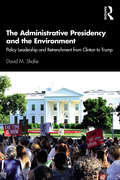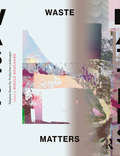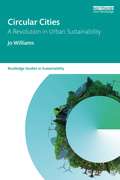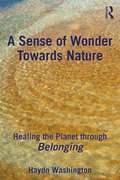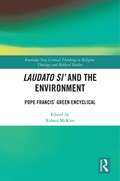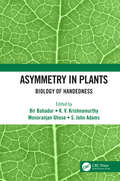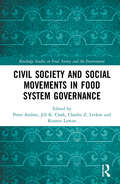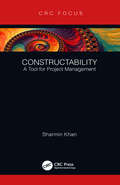- Table View
- List View
The Administrative Presidency and the Environment: Policy Leadership and Retrenchment from Clinton to Trump
by David M. ShafieThe growth of the administrative state and legislative gridlock has placed the White House at the center of environmental policymaking. Every recent president has continued the trend of relying upon administrative tools and unilateral actions to either advance or roll back environmental protection policies. From natural resources to climate change and pollution control, presidents have more been willing to test the limits of their authority, and the role of Congress has been one of reacting to presidential initiatives. In The Administrative Presidency and the Environment: Policy Leadership and Retrenchment from Clinton to Trump, David M. Shafie draws upon staff communications, speeches and other primary sources. Key features include detailed case studies in public land management, water quality, toxics, and climate policy, with particular attention to the role of science in decisionmaking. Finally, he identifies the techniques from previous administrations that made Trump’s administrative presidency possible. Shafie’s combination of qualitative analysis and topical case studies offers advanced undergraduate students and researchers alike important insights for understanding the interactions between environmental groups and the executive branch as well as implications for future policymaking.
The Administrative Presidency and the Environment: Policy Leadership and Retrenchment from Clinton to Trump
by David M. ShafieThe growth of the administrative state and legislative gridlock has placed the White House at the center of environmental policymaking. Every recent president has continued the trend of relying upon administrative tools and unilateral actions to either advance or roll back environmental protection policies. From natural resources to climate change and pollution control, presidents have more been willing to test the limits of their authority, and the role of Congress has been one of reacting to presidential initiatives. In The Administrative Presidency and the Environment: Policy Leadership and Retrenchment from Clinton to Trump, David M. Shafie draws upon staff communications, speeches and other primary sources. Key features include detailed case studies in public land management, water quality, toxics, and climate policy, with particular attention to the role of science in decisionmaking. Finally, he identifies the techniques from previous administrations that made Trump’s administrative presidency possible. Shafie’s combination of qualitative analysis and topical case studies offers advanced undergraduate students and researchers alike important insights for understanding the interactions between environmental groups and the executive branch as well as implications for future policymaking.
Waste Matters: Adaptive Reuse for Productive Landscapes
by Nikole BouchardFor thousands of years humans have experimented with various methods of waste disposal—from burning and burying to simply packing up and moving in search of an unscathed environment. Habits of disposal are deeply ingrained in our daily lives, so casual and continual that we rarely ever stop to ponder the big-picture effects on social, spatial and ecological orders. Rethinking the ways in which we produce, collect, discard and reuse our waste, whether it’s materials, spaces or places, is essential to ensure a more feasible future. Waste Matters: Adaptive Reuse for Productive Landscapes presents a series of historical and contemporary design ideas that reimagine a range of repurposed materials at diverse scales and in various contexts by exploring methods of hacking, disassembly, reassembly, recycling, adaptive reuse and preservation of the built environment. Waste Matters will inspire designers to sample and rearrange bits of artifacts from the past and present to produce culturally relevant and ecologically sensitive materials, objects, architecture and environments.
Waste Matters: Adaptive Reuse for Productive Landscapes
by Nikole BouchardFor thousands of years humans have experimented with various methods of waste disposal—from burning and burying to simply packing up and moving in search of an unscathed environment. Habits of disposal are deeply ingrained in our daily lives, so casual and continual that we rarely ever stop to ponder the big-picture effects on social, spatial and ecological orders. Rethinking the ways in which we produce, collect, discard and reuse our waste, whether it’s materials, spaces or places, is essential to ensure a more feasible future. Waste Matters: Adaptive Reuse for Productive Landscapes presents a series of historical and contemporary design ideas that reimagine a range of repurposed materials at diverse scales and in various contexts by exploring methods of hacking, disassembly, reassembly, recycling, adaptive reuse and preservation of the built environment. Waste Matters will inspire designers to sample and rearrange bits of artifacts from the past and present to produce culturally relevant and ecologically sensitive materials, objects, architecture and environments.
Circular Cities: A Revolution in Urban Sustainability (Routledge Studies in Sustainability)
by Jo WilliamsWith cities striving to meet sustainable development goals, circular urban systems are gaining momentum, especially in Europe. This research-based book defines the circular city and circular development. It explains the shift in focus from a purely economic concept, which promotes circular business models in cities, to one that explores a new approach to urban development. This approach offers huge opportunities and addresses important sustainability issues: resource consumption and waste; climate change; the health of urban populations; social inequalities and the creation of sustainable urban economies. It examines the different approaches to circular development, drawing on research conducted in four European cities: Amsterdam, London, Paris and Stockholm. It explores different development pathways and levers for a circular urban transformation. It highlights the benefits of adopting a circular approach to development in cities, but acknowledges that these benefits are not shared equally across society. Finally, it focuses on the challenges to implementing circular development faced by urban actors. This ground-breaking book will be essential reading to scholars, students, practitioners and policymakers interested in the circular economy, urban sustainability, urban ecology, urban planning, urban regeneration, urban resilience, adaptive cities and regenerative cities.
Circular Cities: A Revolution in Urban Sustainability (Routledge Studies in Sustainability)
by Jo WilliamsWith cities striving to meet sustainable development goals, circular urban systems are gaining momentum, especially in Europe. This research-based book defines the circular city and circular development. It explains the shift in focus from a purely economic concept, which promotes circular business models in cities, to one that explores a new approach to urban development. This approach offers huge opportunities and addresses important sustainability issues: resource consumption and waste; climate change; the health of urban populations; social inequalities and the creation of sustainable urban economies. It examines the different approaches to circular development, drawing on research conducted in four European cities: Amsterdam, London, Paris and Stockholm. It explores different development pathways and levers for a circular urban transformation. It highlights the benefits of adopting a circular approach to development in cities, but acknowledges that these benefits are not shared equally across society. Finally, it focuses on the challenges to implementing circular development faced by urban actors. This ground-breaking book will be essential reading to scholars, students, practitioners and policymakers interested in the circular economy, urban sustainability, urban ecology, urban planning, urban regeneration, urban resilience, adaptive cities and regenerative cities.
The Shifting Sands of the North Sea Lowlands: Literary and Historical Imaginaries (Routledge Environmental Humanities)
by Katie RitsonGlobal seawater levels are rising and the low-lying coasts of the North Sea basin are amongst the most vulnerable in Europe. In our current moment of environmental crisis, the North Sea coasts are literary arenas in which the challenges and concerns of the Anthropocene are being played out. This book shows how the fragile landscapes around the North Sea have served as bellwethers for environmental concern both now and in the recent past. It looks at literary sources drawn from the countries around the North Sea (Denmark, Germany, the Netherlands, and England) from the mid-nineteenth century onwards, taking them out of their established national and cultural contexts and reframing them in the light of human concern with fast-changing and hazardous environments. The six chapters serve as literary case studies that highlight memories of flood disaster and recovery, attempts to engineer the landscape into submission, perceptions of the landscape as both local and global, and the imagination of the future of our planet. This approach, which combines environmental history and ecocriticism, shows the importance of cultural artefacts in understandings of, and responses to, environmental change, and advocates for the importance of literary studies in the environmental humanities. This book will be of great interest to students and scholars of the Environmental Humanities, including Eco-criticism and Environmental History, as well as anyone studying literature from the Germanic philologies.
The Shifting Sands of the North Sea Lowlands: Literary and Historical Imaginaries (Routledge Environmental Humanities)
by Katie RitsonGlobal seawater levels are rising and the low-lying coasts of the North Sea basin are amongst the most vulnerable in Europe. In our current moment of environmental crisis, the North Sea coasts are literary arenas in which the challenges and concerns of the Anthropocene are being played out. This book shows how the fragile landscapes around the North Sea have served as bellwethers for environmental concern both now and in the recent past. It looks at literary sources drawn from the countries around the North Sea (Denmark, Germany, the Netherlands, and England) from the mid-nineteenth century onwards, taking them out of their established national and cultural contexts and reframing them in the light of human concern with fast-changing and hazardous environments. The six chapters serve as literary case studies that highlight memories of flood disaster and recovery, attempts to engineer the landscape into submission, perceptions of the landscape as both local and global, and the imagination of the future of our planet. This approach, which combines environmental history and ecocriticism, shows the importance of cultural artefacts in understandings of, and responses to, environmental change, and advocates for the importance of literary studies in the environmental humanities. This book will be of great interest to students and scholars of the Environmental Humanities, including Eco-criticism and Environmental History, as well as anyone studying literature from the Germanic philologies.
A Sense of Wonder Towards Nature: Healing the Planet through Belonging
by Haydn WashingtonEnvironmental scientist and writer Haydn Washington argues that we will not solve the environmental crisis unless we change our worldview and ethics, and to do so we must rejuvenate our sense of wonder at nature. This book focuses on humanity’s relation with nature, and the sense of wonder and belonging common to indigenous cultures and children everywhere. Drawing on events in the author’s own four decades working to protect wild places, and the current literature on wonder, it examines what a sense of wonder is, what it has been called in different cultures, and our high points of wonder at nature. It also looks at the ‘Great Divide’ in worldview between anthropocentrism and ecocentrism, and considers the problem of anthropocentric theory in academia, arguing that the focus should instead be on harmony with nature. The book concludes with an examination of why wonder has become buried in Western society and considers ways in which it can be revived, including rituals and education. It also considers how wonder helps humanity to become ‘whole’. The final chapter presents the road back to wonder and how wonder towards nature can be restored in Western society. This book will be of great interest to environmental scientists, conservation biologists, environmental philosophers and ecological ethicists, as well as environmentalists, educators, eco-psychologists, and students looking at sustainability, deep ecology, and environmental philosophy and ethics.
A Sense of Wonder Towards Nature: Healing the Planet through Belonging
by Haydn WashingtonEnvironmental scientist and writer Haydn Washington argues that we will not solve the environmental crisis unless we change our worldview and ethics, and to do so we must rejuvenate our sense of wonder at nature. This book focuses on humanity’s relation with nature, and the sense of wonder and belonging common to indigenous cultures and children everywhere. Drawing on events in the author’s own four decades working to protect wild places, and the current literature on wonder, it examines what a sense of wonder is, what it has been called in different cultures, and our high points of wonder at nature. It also looks at the ‘Great Divide’ in worldview between anthropocentrism and ecocentrism, and considers the problem of anthropocentric theory in academia, arguing that the focus should instead be on harmony with nature. The book concludes with an examination of why wonder has become buried in Western society and considers ways in which it can be revived, including rituals and education. It also considers how wonder helps humanity to become ‘whole’. The final chapter presents the road back to wonder and how wonder towards nature can be restored in Western society. This book will be of great interest to environmental scientists, conservation biologists, environmental philosophers and ecological ethicists, as well as environmentalists, educators, eco-psychologists, and students looking at sustainability, deep ecology, and environmental philosophy and ethics.
The Dance of Death in Late Medieval and Renaissance Europe: Environmental Stress, Mortality and Social Response (Routledge Environmental Humanities)
by Andrea Kiss Kathleen PribylThis volume investigates environmental and political crises that occurred in Europe during the late Middle Ages and the early Modern Period, and considers their effects on people’s lives. At this time, the fragile human existence was imagined as a ‘Dance of Death’, where anyone, regardless of social status or age, could perish unexpectedly. This book covers events ranging from cooling temperatures and the onset of the Little Ice Age, to the frequent occurrence of epidemic disease, pest infestations, food shortages and famines. Covering the mid-fourteenth to mid-seventeenth centuries, this collection of essays considers a range of countries between Iceland (to the north), Italy (to the south), France (to the west) and the westernmost parts of Russia (to the east). This wide-reaching volume considers how deeply climate variability and changes affected and changed society in the late medieval to early modern period, and asks what factors, other than climate, interfered in the development of environmental stress and socio-economic crises. This book will be of great interest to students and scholars of Environmental and Climate History, Environmental Humanities, Medieval and Early Modern History and Historical Geography, as well as Climate Change and Environmental Sciences.
The Dance of Death in Late Medieval and Renaissance Europe: Environmental Stress, Mortality and Social Response (Routledge Environmental Humanities)
by Andrea Kiss Kathleen PribylThis volume investigates environmental and political crises that occurred in Europe during the late Middle Ages and the early Modern Period, and considers their effects on people’s lives. At this time, the fragile human existence was imagined as a ‘Dance of Death’, where anyone, regardless of social status or age, could perish unexpectedly. This book covers events ranging from cooling temperatures and the onset of the Little Ice Age, to the frequent occurrence of epidemic disease, pest infestations, food shortages and famines. Covering the mid-fourteenth to mid-seventeenth centuries, this collection of essays considers a range of countries between Iceland (to the north), Italy (to the south), France (to the west) and the westernmost parts of Russia (to the east). This wide-reaching volume considers how deeply climate variability and changes affected and changed society in the late medieval to early modern period, and asks what factors, other than climate, interfered in the development of environmental stress and socio-economic crises. This book will be of great interest to students and scholars of Environmental and Climate History, Environmental Humanities, Medieval and Early Modern History and Historical Geography, as well as Climate Change and Environmental Sciences.
Laudato Si’ and the Environment: Pope Francis’ Green Encyclical (Routledge New Critical Thinking in Religion, Theology and Biblical Studies)
by Robert McKimThis volume is a response to Pope Francis’ environmental encyclical Laudato Si’. Published in 2015, the encyclical urges us to face up to the crisis of climate change and to take better care of the Earth, our common home, while also attending to the plight of the poor. In this book the Pope’s invitation to all people to begin a new dialogue about these matters is considered from a variety of perspectives by an international and multidisciplinary team of leading scholars. There is discussion of the implications of Laudato Si’ for immigration, population control, eating animals, and property ownership. Additionally, indigenous religious perspectives, development and environmental protection, and the implementation of the ideas of the encyclical within the Church are explored. Some chapters deal with scriptural or philosophical aspects of the encyclical. Others focus on central concepts, such as interconnectedness, the role of practice, and what Pope Francis calls the "technocratic paradigm." This book expertly illuminates the relationship between Laudato Si’ and environmental concerns. It will be of deep interest to anyone studying religion and the environment, environmental ethics, Catholic theology, or environmental thought.
Laudato Si’ and the Environment: Pope Francis’ Green Encyclical (Routledge New Critical Thinking in Religion, Theology and Biblical Studies)
by Robert McKimThis volume is a response to Pope Francis’ environmental encyclical Laudato Si’. Published in 2015, the encyclical urges us to face up to the crisis of climate change and to take better care of the Earth, our common home, while also attending to the plight of the poor. In this book the Pope’s invitation to all people to begin a new dialogue about these matters is considered from a variety of perspectives by an international and multidisciplinary team of leading scholars. There is discussion of the implications of Laudato Si’ for immigration, population control, eating animals, and property ownership. Additionally, indigenous religious perspectives, development and environmental protection, and the implementation of the ideas of the encyclical within the Church are explored. Some chapters deal with scriptural or philosophical aspects of the encyclical. Others focus on central concepts, such as interconnectedness, the role of practice, and what Pope Francis calls the "technocratic paradigm." This book expertly illuminates the relationship between Laudato Si’ and environmental concerns. It will be of deep interest to anyone studying religion and the environment, environmental ethics, Catholic theology, or environmental thought.
Asymmetry in Plants: Biology of Handedness
by Bir Bahadur K. V. Krishnamurthy Monoranjan Ghose S. John AdamsPlants exhibit forms of asymmetry analogous to "handedness" in bilaterally symmetrical animals. This book explores the evolutionary significance and development of asymmetry. Examples of genetic control include the direction of tendril or stem coiling of many climbing plants; the so-called spiral phyllotaxy and floral taxy; and contorted petal arrangement is another kind of left- right symmetry in plants; the direction of contortion is fixed in some but not in other plants. The book will underscore tha all phenomena related to handedness start during embryogenesis itself, with the occurrence of embryo rotation. Key selling features: First consolidated book on Plant Handedness Relates handedness, asymmetry and chirality to the evolution of different organizational levels in plant biology Emphasizes handedness as a vital governing force in plant functional evolution Provides a new perspective, hitherto ignored, into plant developemtn and evolution Describes how an age-old phenomenon can give scope for investigation from a very modern interdisciplinary approach
Asymmetry in Plants: Biology of Handedness
by Bir Bahadur K. V. Krishnamurthy Manoranjan Ghose S. John AdamsPlants exhibit forms of asymmetry analogous to "handedness" in bilaterally symmetrical animals. This book explores the evolutionary significance and development of asymmetry. Examples of genetic control include the direction of tendril or stem coiling of many climbing plants; the so-called spiral phyllotaxy and floral taxy; and contorted petal arrangement is another kind of left- right symmetry in plants; the direction of contortion is fixed in some but not in other plants. The book will underscore tha all phenomena related to handedness start during embryogenesis itself, with the occurrence of embryo rotation. Key selling features: First consolidated book on Plant Handedness Relates handedness, asymmetry and chirality to the evolution of different organizational levels in plant biology Emphasizes handedness as a vital governing force in plant functional evolution Provides a new perspective, hitherto ignored, into plant developemtn and evolution Describes how an age-old phenomenon can give scope for investigation from a very modern interdisciplinary approach
A History of Energy Flows: From Human Labor to Renewable Power
by Anthony N. PennaThis book presents a global and historical perspective of energy flows during the last millennium. The search for sustainable energy is a key issue dominating today’s energy regime. This book details the historical evolution of energy, following the overlapping and slow flowing transitions from one regime to another. In doing so it seeks to provide insight into future energy transitions and the means of utilizing sustainable energy sources to reduce humanity’s fossil fuel footprint. The book begins with an examination of the earliest and most basic forms of energy use, namely, that of humans metabolizing food in order to work, with the first transition following the domestication and breeding of horses and other animals. The book also examines energy sources key to development during the industrialization and mechanization, such as wood and coal, as well as more recent sources, such as crude oil and nuclear energy. The book then assesses energy flows that are at the forefront of sustainability, by examining green sources, such as solar, wind power and hydropower. While it is easy to see energy flows in terms of “revolutions,” transitions have taken centuries to evolve, and transitions are never fully global, as, for example, wood remains the primary fuel source for cooking in much of the developing world. This book not only demonstrates the longevity of energy transitions but also discusses the possibility for reducing transition times when technological developments provide inexpensive and safe energy sources that can reduce the dependency on fossil fuels. This book will be of great interest to students and scholars of energy transitions, sustainable energy and environmental and energy history.
A History of Energy Flows: From Human Labor to Renewable Power
by Anthony N. PennaThis book presents a global and historical perspective of energy flows during the last millennium. The search for sustainable energy is a key issue dominating today’s energy regime. This book details the historical evolution of energy, following the overlapping and slow flowing transitions from one regime to another. In doing so it seeks to provide insight into future energy transitions and the means of utilizing sustainable energy sources to reduce humanity’s fossil fuel footprint. The book begins with an examination of the earliest and most basic forms of energy use, namely, that of humans metabolizing food in order to work, with the first transition following the domestication and breeding of horses and other animals. The book also examines energy sources key to development during the industrialization and mechanization, such as wood and coal, as well as more recent sources, such as crude oil and nuclear energy. The book then assesses energy flows that are at the forefront of sustainability, by examining green sources, such as solar, wind power and hydropower. While it is easy to see energy flows in terms of “revolutions,” transitions have taken centuries to evolve, and transitions are never fully global, as, for example, wood remains the primary fuel source for cooking in much of the developing world. This book not only demonstrates the longevity of energy transitions but also discusses the possibility for reducing transition times when technological developments provide inexpensive and safe energy sources that can reduce the dependency on fossil fuels. This book will be of great interest to students and scholars of energy transitions, sustainable energy and environmental and energy history.
Sacrificing The Forest: Environmental And Social Struggle In Chiapas
by Karen O'BrienThe Selva Lacandona of Chiapas, Mexico has received a tremendous amount of attention since the Zapatista uprising began in 1994. Concerns have focused on both the rapid rate of deforestation in Mexico's largest tropical rain forest and the social marginalization of its inhabitants, which is considered to be a root cause of the uprising. In this book, Karen O'Brien presents an insightful analysis of how deforestation and social struggles are related in this region and then considers the implications of these links for the remaining forest.A critical analysis of deforestation rates and patterns in the Selva Lacandona region provides the point of departure for this study. Using satellite imagery and her own field work, O'Brien presents an original estimate of forest loss. She then uses an approach derived from political ecology to trace the links between social processes and deforestation. Instead of focusing exclusively on the driving forces of deforestation, she argues that an analysis of the countervailing forces of conservation efforts is crucial to understanding the configuration of the present-day forest and the conflicts that surround it. Unless these forces can be fused, O'Brien contends, the future of the Selva Lacandona will continue to be shaped by the tensions among social, economic, and environmental objectives.A valuable tool for scholars of deforestation, environmental change, and political ecology, Sacrificing the Forest will also be of interest to readers trying to understand the current situation in Chiapas.
Sacrificing The Forest: Environmental And Social Struggle In Chiapas
by Karen O'BrienThe Selva Lacandona of Chiapas, Mexico has received a tremendous amount of attention since the Zapatista uprising began in 1994. Concerns have focused on both the rapid rate of deforestation in Mexico's largest tropical rain forest and the social marginalization of its inhabitants, which is considered to be a root cause of the uprising. In this book, Karen O'Brien presents an insightful analysis of how deforestation and social struggles are related in this region and then considers the implications of these links for the remaining forest.A critical analysis of deforestation rates and patterns in the Selva Lacandona region provides the point of departure for this study. Using satellite imagery and her own field work, O'Brien presents an original estimate of forest loss. She then uses an approach derived from political ecology to trace the links between social processes and deforestation. Instead of focusing exclusively on the driving forces of deforestation, she argues that an analysis of the countervailing forces of conservation efforts is crucial to understanding the configuration of the present-day forest and the conflicts that surround it. Unless these forces can be fused, O'Brien contends, the future of the Selva Lacandona will continue to be shaped by the tensions among social, economic, and environmental objectives.A valuable tool for scholars of deforestation, environmental change, and political ecology, Sacrificing the Forest will also be of interest to readers trying to understand the current situation in Chiapas.
Civil Society and Social Movements in Food System Governance (Routledge Studies in Food, Society and the Environment)
by Peter Andrée Jill K. Clark Charles Z. Levkoe Kristen LowittThis book offers insights into the governance of contemporary food systems and their ongoing transformation by social movements. As global food systems face multiple threats and challenges there is an opportunity for social movements and civil society to play a more active role in building social justice and ecological sustainability. Drawing on case studies from Canada, the United States, Europe and New Zealand, this edited collection showcases promising ways forward for civil society actors to engage in governance. The authors address topics including: the variety of forms that governance engagement takes from multi-stakeholderism to co-governance to polycentrism/self-governance; the values and power dynamics that underpin these different types of governance processes; effective approaches for achieving desired values and goals; and, the broader relationships and networks that may be activated to support change. By examining and comparing a variety of governance innovations, at a range of scales, the book offers insights for those considering contemporary food systems and their ongoing transformation. It is suitable for food studies students and researchers within geography, environmental studies, anthropology, policy studies, planning, health sciences and sociology, and will also be of interest to policy makers and civil society organisations with a focus on food systems. The Open Access version of this book, available at http://www.tandfebooks.com/doi/view/10.4324/9780429503597, has been made available under a Creative Commons Attribution-Non Commercial-No Derivatives 4.0 license.
Civil Society and Social Movements in Food System Governance (Routledge Studies in Food, Society and the Environment)
by Peter Andrée Jill K. Clark Charles Z. Levkoe Kristen LowittThis book offers insights into the governance of contemporary food systems and their ongoing transformation by social movements. As global food systems face multiple threats and challenges there is an opportunity for social movements and civil society to play a more active role in building social justice and ecological sustainability. Drawing on case studies from Canada, the United States, Europe and New Zealand, this edited collection showcases promising ways forward for civil society actors to engage in governance. The authors address topics including: the variety of forms that governance engagement takes from multi-stakeholderism to co-governance to polycentrism/self-governance; the values and power dynamics that underpin these different types of governance processes; effective approaches for achieving desired values and goals; and, the broader relationships and networks that may be activated to support change. By examining and comparing a variety of governance innovations, at a range of scales, the book offers insights for those considering contemporary food systems and their ongoing transformation. It is suitable for food studies students and researchers within geography, environmental studies, anthropology, policy studies, planning, health sciences and sociology, and will also be of interest to policy makers and civil society organisations with a focus on food systems. The Open Access version of this book, available at http://www.tandfebooks.com/doi/view/10.4324/9780429503597, has been made available under a Creative Commons Attribution-Non Commercial-No Derivatives 4.0 license.
Constructability: A Tool for Project Management
by Sharmin KhanThis book focuses on Constructability, a project management tool and its effectiveness in promotion of sustainable development and architecture. Constructability concentrates on the optimum use of construction knowledge and experience in planning, engineering, procurement and field operations to achieve overall project objectives. Keeping in view the requirement of promotion of sustainable architectural practices, the book is aimed at establishing effective relationship between constructability and sustainability, including application of the project management systems and guidelines for sustainable development, in a systematic manner. Key Features Focuses on relationship between constructability and sustainability in detail, with respect to their definitions and historical background. Summarizes formulation of recommendations and guidelines for various design and construction practices Provides an updated information database having overview of constructability studies and researches conducted so far Explores association of sustainable development to project management issues Includes relevant case studies
Constructability: A Tool for Project Management
by Sharmin KhanThis book focuses on Constructability, a project management tool and its effectiveness in promotion of sustainable development and architecture. Constructability concentrates on the optimum use of construction knowledge and experience in planning, engineering, procurement and field operations to achieve overall project objectives. Keeping in view the requirement of promotion of sustainable architectural practices, the book is aimed at establishing effective relationship between constructability and sustainability, including application of the project management systems and guidelines for sustainable development, in a systematic manner. Key Features Focuses on relationship between constructability and sustainability in detail, with respect to their definitions and historical background. Summarizes formulation of recommendations and guidelines for various design and construction practices Provides an updated information database having overview of constructability studies and researches conducted so far Explores association of sustainable development to project management issues Includes relevant case studies
Communication Strategies for Engaging Climate Skeptics: Religion and the Environment (Routledge Advances in Climate Change Research)
by Emma Frances BloomfieldCommunication Strategies for Engaging Climate Skeptics examines the intersection of climate skepticism and Christianity and proposes strategies for engaging climate skeptics in productive conversations. Despite the scientifically established threats of climate change, there remains a segment of the American population that is skeptical of the scientific consensus on climate change and the urgent need for action. One of the most important stakeholders and conversants in environmental conversations is the religious community. While existing studies have discussed environmentalism as a factor within the religious community, this book positions religion as an important factor in environmentalism and focuses on how identities play a role in environmental conversation. Rather than thinking of religious skeptics as a single unified group, Emma Frances Bloomfield argues that it is essential to recognize there are different types of skeptics so that we can better tailor our communication strategies to engage with them on issues of the environment and climate change. To do so, this work breaks skeptics down into three main types: "separators," "bargainers," and "harmonizers." The book questions monolithic understandings of climate skepticism and considers how competing narratives such as religion, economics, and politics play a large role in climate communication. Considering recent political moves to remove climate change from official records and withdraw from international environmental agreements, it is imperative now more than ever to offer practical solutions to academics, practitioners, and the public to change the conversation. To address these concerns, this book provides both a theoretical examination of the rhetoric of religious climate skeptics and concrete strategies for engaging the religious community in conversations about the environment. This book will be of great interest to students, scholars, and practitioners of climate change science, environmental communication, environmental policy, and religion.
